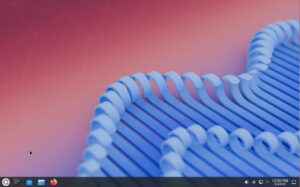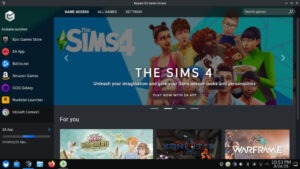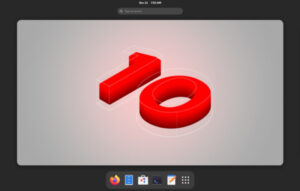Earlier in the week, my FOSS Force colleague Ken Starks wrote a very poignant column on these pages about how there’s no room for the kind of bullying and other varieties of douchebaggery which seems to appear all too often in forums.
That’s something that really bugs me. Not the fact that Ken brought it up, of course, but the fact that people don’t have the common decency to act with civility in the public realm. When someone responded they way they did to Ken as he describes, I’m grabbing some popcorn because Ken has the unique ability to use words like a Ginsu knife to slice and dice such hapless assclowns before they know what hit them.
But back to my point: The lack of civility and reasonable goodwill that some malcontents show in the FOSS realm bothers me.
Do you know what else bothers me? Glad you asked.

(Photo credit: Larry the Free Software Guy blog)
But whose idea was it to make the KDE icon on the default splash screen literally twice the size of the other icons? For those who aren’t KDE users, you get a march of the icons during the boot process –- hard drive, utilities, Internet connectivity, desktop…and then a huge KDE logo which, I assume, means the desktop environment is ready. But what it really says is “yeah, your system is ready to go, and we at KDE have such an inferiority complex that we have to make the desktop logo twice as big to make sure you know what you’re using.”
C’mon, KDE guys and gals: I’m no graphic artist, but don’t you think it would look cooler if the KDE logo icon was more like the rest of the icons, instead of big enough to appear to have taken performance-enhancing steroids?
The best distro is $MY_DISTRO: Zealots come and zealots go, but they seem to always overstay their welcome in the FOSS realm. You would think that someone who has more than two IQ points to rub together would realize that perhaps his or her distro may not be best for someone else. Sadly, that’s not the case. It’s My Distro Uber Alles for them, and if you’re not using the distro they use, then you must be an idiot.
They’re wrong, of course. We know who the real idiots are, and they need to stop this nonsense.
At last count there were 292 Linux and BSD based distros on Distrowatch. It should be 293 because Bodhi Linux –- and I expect someone to continue developing the distro that Jeff and his team started –- should be on the list and isn’t. But 293 is just the right number of distros; the beauty of FOSS is that you have a choice. Let me repeat that: Choice is good, and the more distros there are, the better it is.
So the best distro? That’s easy –- it’s the one that works for you, period. Don’t let anyone tell you otherwise. If it’s the ever popular Ubuntu, great. If it’s KXStudio, a Portuguese distro based on Ubuntu leaning toward audio production and ranking at 292 on Distrowatch.com, then more power to you. Anything in between? Cool.
There are other things that bug me too: IKEA, the Los Angeles Dodgers and traffic, but none of that has any relevance here. Got something in the FOSS realm that bugs you? Tell me in the comments.











I’m a gentooer and it’s certainly about the best possible distro /for/ /me/, fully customizable including the ability to automatically apply patches I come up with to future updates, something I definitely take advantage of for some packages, but I’m also on record as repeatedly reminding folks that there’s no loss of face in simply saying that’s not for you, you’re more comfortable with something different.
Similarly with the desktop. I’m a kdeer and love the customizability, particularly in combination with gentoo, since that allows me to for instance not only turn off the semantic-desktop bits but in fact configure and build kde without them. But I’m certainly glad there’s a gnome as well, for those who want something that just works and who are afraid of all those options kde exposes, because without it being there, some of those folks would be on kde trying to remove its customizability, and that would be a crime! =:^) Similarly, I’m sure many of the gnome folks are glad kde is there, so folks that want all that configurability won’t be trying to spoil gnome’s vision of its one perfect way!
And that isn’t to diminish all the other alternatives as well. I find the perfect number of distros, and desktops, to be the number that people have taken the trouble to make. If it wasn’t worth their trouble, they wouldn’t have taken the time, so it clearly is, at least to them. And once they’ve done it for themselves, they might as well make it available to others as well. =:^)
Which is why I’m not too bothered when a distro disappears, either. Obviously the author(s) found no need of it any longer, or it’d still be worth their trouble. If there’s still a need for it, someone else will either pick it up, as is apparently happening with Bodhi, or another will come to replace it. If not, well, it has its place in history in filling a need while it was there.
As for the kde splash, of course you can choose other splash themes in its place. Or do as I did (assuming your distro makes it as easy as mine does, I /did/ say mine was about the perfect match for me =:^) and uninstall the entire ksplash package. Now I have a bare black X desktop as kde starts, first displaying my gentoo-pointer-theme mouse pointer, then coming up with kde’s plasma-desktop activities. The splash would only be there for a few seconds anyway (here, all but the last icon appeared at once, followed by the last one, then the splash was gone), and it’s unnecessary bloat to load at kde startup and slow down the loading of the rest of kde just that much further, so away with it! =:^)
Duncan
I hate hypocrites:
“KDE has too many options, it’s bloated!”, yet “GIMP is not bloated, it’s feature-complete”.
Hypocrates!
“The registry in Windows is binary, it’s an abomination!”, yet they welcome systemd’s binary logs with open arms.
Hypocrates!
Guys who create a “linux” show, yet they do all the production on Macs.
Hypocrates!
Guys like Miguel de Icaza, who help found Gnome, then start working with Microsoft, and eventually leave Linux to start using Macs.
Hypocrates!
Users who will cry out loud for always having the latest software… yet critize distros that are rolling releases for being “too risky”.
Hypocrates!
Man, this list could go on for a long time…
I think that KDE splash screen layout is specific to Fedora; at least, I’ve never seen it on any other distribution.
“Choice” in terms of distros is a bit of a misnomer because most distros are packaging efforts. We need more emphasis on the creation of innovative software in addition to the easier endless minor forks. And FOSS is desperate for a reliable way to measure user response to software. Forum and other online postings are unreliable because they’re typically agenda driven, if not just people piling on for the fun of it.
Plus, folks are not going to adopt FOSS because it’s “free”, either its cost or its source. That notion has been tested for a few decades, now, and it seems pretty clear that it’s not enough to change most folks’ habits.
Know what I hate? Having trouble getting to sleep and then when I really get it going, I wake up at 4:30 and NOTHING will let me go back. Now I can’t find the tubing for my IV caffeine so I’m not even functioning up to the subnormal level…and…I open up a Larry’s FossForce column that all but BEGS me to let fly with a list of gripes and NOTHING comes to mind. Absolutely…nothing. (Ken is involuntarily giving me lessons on three-dot journalism.)
I have my laptop on my desk with a second monitor so I have email on the left and the web on the right and I finish a web page and hit CTRL+W to close it–and I wasn’t paying attention (see caffeine above) and the focus was on left so the email totally closes out. I fire it up again and it opens on the right so I move it over and go to close the web page…and I just had the mouse on the email when I was moving it over, so the email closes again.
Okay, I get that figured out (see subnormal above) and read Larry’s gripe about the size of the KDE logo. Hey! Maybe I have something to work with…but Clem switched out the oversized KDE logo for a little gear with an “M” in the middle (Mint 17 KDE) and it’s the same size as all the other icons. Since that’s the first letter of my last name, I can’t even complain that he won’t let me personalize it. Rats!
Already did my updates and have a new BASH, so that’s done. What’s left over from yesterday? I skewered a guy on alt.something.mint after his 114th episode of feminine hygiene appliance and it’s all quiet and well-behaved this morning. Maybe nobody is up yet. But nothing to do there. Got my lawn outlined and trimmed late in the afternoon, waiting for me to plop down on the rider and play Mario Andretti soon as the dew dries off. It’ll be lunchtime in this humidity. In desperation, I threw in a load of laundry and put the dishes in the dishmasher a while ago. What else is there in this life?
Guess I’ll check Dilbert and UserFriendly and then I’ll probably fall asleep on the keyboard and get qwertyface.
And snot-nosed little boys with attitudes and temper tantrums.
And old men with their waist band up to their arm pits who don’t like change of any kind or talk about the future.
And anything not Open Source.
Duncan: Excellent post and perfect example of why FOSS is great: Different strokes for different folks. On the issue of distros dying — I don’t mind the “market forces” (or lack thereof) swallowing up a distro that’s subpar, but there have been some stellar distros which have gone by the wayside for reasons unreleated to their quality (and mostly related to life changes by the lead developers) — Wolvix and SolusOS are two, and Bodhi would fall into this category if no one picks it up.
joncr: I’ve seen the splash screen with the oversized KDE logo in both Fedora and in PCLinuxOS. Also, in posting the question on the KDE forum “Is the KDE logo too big or is it just me?” The prevailing answer was, “It’s you.” So much for dissenting viewpoints.
On the issue of the KDE logo and where the icon appears larger than the other icons, let me add this: True, I could change my splash screen, but it doesn’t alter the situation where the default is, at least in my opinion, faulty.
Stupid subpar distros, always getting swallowed up by the big fish! Seriously though, I wish more people would invest their time in smaller distros so things that shouldn’t affect the distro’s volunteers, like life changes won’t affect them as much. It’s hard to run a small distro, harder than anyone who hasn’t done so realizes. Especially so when upstream hates you, users want their fixes right away (rightfully so), and you’re draining your bank account just to host it all.
The problem of small distros dying is a problem for the community as a whole to solve, it won’t ever be solved until it’s recognized as an actual problem.
Funny you should mention the “K thing” in ksplash Larry. Since the beginning, that larger “K” has sent me into OCD Full Twitch Mode. Fortunately there are some ksplash screens that put aside that size inferiority complex and work nicely. I can’t find any online screencasts or shots that display their characteristics but the list below has them in “Get New Themes”. You can install them then use the “preview theme” feature at the bottom of the installation gui. They can also be removed if that particular theme doesn’t suit you.
Here’s to a non pharmaceutical way to deal with those few twitchy boot moments.
codekde
fusion
gutschy
NewEssenceFinal
PumpTux
Steampunk
speedometer
Larry/joncr: The big K is indeed the default icon, and that the default splash, as shipped by KDE.
+Ken: I always thought it looked a bit odd, but fortunately it wasn’t something I OCDed over. I figured it was that way since that was the last icon, thus the one most people are waiting to see, as when they see it they’re almost there. Well, that and the fact that being squarish it uses more of its bounding rectangle than the circles, so it looks even bigger in comparison to the others than it actually is in WxH.
But like I said I tried a few others for variety, then decided to dump ksplash entirely, IIRC when I switched to kde-live (using the live-kde4 ebuilds in the gentoo/kde overlay), since at least at the time it was still subversion-based while most of kde has switched to git, and I was trying to avoid having to install subversion. I ended up installing subversion anyway, for kde’s icon theme package (IDR the name), tho I could have simply continued bumping it to the latest stable as necessary but wanted all-live-kde. But by the time I did so I’d decided all the other subversion-based packages were unnecessary and uninstalled them.
Andrew: Thanks for weighing in. Fuduntu, of course, is another exceptional distro that left us too early as well (apologies, I should have included it in the examples). You are right — I think that folks contributing to smaller distros helps the rising tide bring all the ships up. The “problem” you present is definitely something that should be addressed, and it sounds like a good topic for a story . . . .
Ken/Duncan: Thanks, Ken — I know you and I have discussed this before and it’s not really a strike issue, but it does bring out the OCD in me. Duncan, I may join you in dumping ksplash entirely. But we’ll see
No worries Larry and no need to apologize; its not really a distro people think about anymore. Look forward to reading your next article. 🙂
KDE 4 is notoriously unattractive UI-wise, or perhaps simply obsolete. But they are trying to overhaul the whole thing with Plasma/KDE 5. So it will all get better soon – unless it all breaks 🙂 KDE also famously lends itself well to all sorts of customizations, splash screens, icon sets, should be no exception. In fact if I remember KDE well, probably each of those individual icons showing up on that splash screen can be changed 🙂
A note about Fedora – they throw “vanilla” DEs on top of the distro, with no intervention. They have no interest in improving or changing anything on that front, because they have zero interest in desktop users. Fedora is meant to test and improve RHEL, and considering the distro is still around it probably does that very well.
Also, I don’t know if Ubuntu’s desire to change and improve things on the desktop, UI and usability-wise, originally led to the split with Gnome. Maybe it was something else. What’s clear now is that Ubuntu no longer cares about the desktop either, while the Gnome people are busy drawing oversized CSD buttons for use on phantom tablets.
Considering that every year is the year of Linux on my desktop, these are the things that “bug” me.
.. since you asked :p
It has been a while since I last used KDE, the only machine I have that will do KDE justice is being used as a mobile recording studio, and I try to keep it lean and mean, so I could be wrong.
But the last time I used KDE all of the icons on the KSplash screen start our small then as that section is loaded they display larger than the others, then shrink back. The final section… the loading of the desktop the “KDE” bit doesn’t get a chance to shrink back, as the system moves on to the login screen/displays the desktop (depending on the user’s boot up choice.
So from memory it’s not that the KDE logo is bigger than the others it’s simply an artifact of how the system loads that it appears that way, just before KSplash exits.
I use the operating system(s) that give me what I want. Ubuntu (Unity), I’m quite happy with that, Linux Mint Cinnamon works well for me too, as does XFCE, KDE would also, if I had a spare machine with a better Graphics card than I have.
I stopped being bugged by a lot of things, I decided it was simply better for my health to move on.
Struggling to cope with this…
Some distros, for example elementaryOS, Voyager, ROSA – all look wonderful ‘out of the box’. Beautiful looking fonts, smooth edges, easy on the eye. Even Trisquel (a 100% libre software distro) manages to look good ‘out of the box’.
Then there’s KDE on Slackware – an exercise in pain.
All I get is scratchy looking fonts. I’ve tried every combination of enforced dpi settings, hinting, etc and it just looks relentlessly primitive. I’ve even copied the KDE font settings down from ROSA Linux and duplicated them on Slackware’s KDE and it just doesn’t look the same. At all.
It does my head in.
So what bugs me most is inconsistent GUI’s and GUI’s that seem to have been added as an after-thought.
And you thought you were going to get a long rant about “people who put proprietary code in a Linux distro and then call it OpenSource”. That bugs me too. Almost as much as nasty looking fonts.
This is probably throwing petrol on a fire, but here goes anyway.
I’ve been watching the angst over systemd, and doing a bit of reading about it, as well, and for the life of me I can’t really see any major issues, other than it’s new, and it replaces an init system that has been around for, I dunno, forever, and most people understand tht old init system, warts and all.
For the most part the biggest problem seems to be one of personalities, rather than anything technical.
As far as the binary logs are concerned, as far as I can tell this is quite a different kettle of fish from the issue of the Windows registry, given that
1. the rational for a binary journal system seems to be to provide an extra layer of security over the logs, in that the binary journals are hashed, which makes any attempt to alter the journals obvious, whereas the current text based log files can be altered rather easily by anyone who has that much access.
2. The Windows registry was designed to be a catch all for all sorts of configuration files, and as such is designed to handle binary configuration data, with all the obvious issues that entails, ie it’s a great place to hide viruses. Given that the Windows registry is designed in this way, there is no simple means of determining whether some of that binary data is in fact malicious.
3.The systemd journals are designed to hold data supplied by the kernel… log data (and that data can be extracted as text, so in principle, anything malicious that might get injected into the journals is more likely to be fairly obvious, for the same reason any attempt to delete data would be.
From my current reading I can’t see that systemd makes much, if any difference to the security of Linux, or the Desktop/userspace that sits on top of it.
Couple things that bug me about FOSS and Linux users/projects in general:
– a culture of spending more time on the OS than using it (“it’s been a while since I last changed distros, time for something new”, “this new release is rather boring and lacks exciting new bells and whistles”). That doesn’t really help ironing out the UI ergonomics, IMHO: too much attention for form over function. It also means that there is very little incentive (reducing the already limited manpower) to maintain older versions.
KDevelop is a good example: choke full of useful features, but it’s never clear what settings apply globally and which ones you’ll have to reconfigure for each and every session you start. Also, you can’t detach edit windows from the MDI to lay them out on that nice big screen in a productive way.
– Dogmatism about standards compliance. While it’s good to comply with standards, it’s never good to impose strict adherence to them because the real world isn’t like that. Example: kmail and imap. “No, you won’t get “Imap Prefix Path” like in Thunderbird because you can do the same thing with subscriptions”. True, but they’re complementary features, subscriptions being exclusive (only the mailboxes you pick) and prefix path being inclusive (all the mailboxes in a given directory, no matter how that collection changes over time and via other clients). Try to make those subscriptions on your localhost imap server where you have hundreds of Gb of files and folders that will have to be scanned before you’ll get the list of available mailboxes…
– Implicit assumption that everyone runs Linux or under X11. That one is deliberately put a bit too boldly, but it’s the impression you get when using Mac OS X like I am.
I’m active in the KDE/Mac “community” and we’re only now at a point where KDE4 becomes truly usable. We keep getting feedback implying that we should be working on KF5 instead, that KDE4 branches are dead, or even that KDE4 will stop compiling in 2 years. We’ll get there, but we’d get there faster with just a bit more support, and things would have gone much more smoothly much sooner if more KDE devs had realised their Qt-based code ought to work on OS X too … and used that OS. As it is, a number of our platform-specific modifications will have to be redesigned because the KDE classes they target have been deprecated in favour of their Qt base classes.
Systemd annoys me. Why? Once upon a time, I was an Archlinux user. Many things that I did not have to change often, but which I did need to change quickly and correctly when change was necessary, were configured in one single self-documenting file, /etc/rc.conf . Then systemd came, and instead of the location of a single file I needed to remember the names of tools and their arguments, and needed to look at help messages and manual pages instead of having my own notes right there in the configuration file. (Guess why I now use BSD when I can?)
I guess journald has a similar problem. I don’t often need to look at logs, but poking around in /var/log for a file that seems to be what you need has to be easier than having to read a manual for the right options of journalctl first (…and having to remember that the thing is called journalctl or whatever it is called).
That’s the practical user interface problem that I have with systemd. The other problems I have with it will be more familiar:
– Integration of projects is nice, except when some of those projects are things you do not want (see above).
– Instead of one semi-monolithic kernel, we now get two semi-monolithic kernels on top of each other. In my opinion Tanenbaum was right, but Linux just happens to have better hardware and software compatibility than MINIX does :/ .
– I do not trust Lennart Poettering, because of the wreck PulseAudio was for a long time and me still not understanding in what way it is supposed to be useful to me. When I wasn’t using Archlinux, removing PulseAudio was one of the first things that I did after installation, because that would magically solve almost all sound problems. With systemd he started another thing without an obvious purpose… I guess I’ll keep it off my systems and watch others debug that piece of change for the sake of change. Pretty much just like I wouldn’t jump into installing Windows if Microsoft open sourced it tomorrow, even though my worst experiences were with 9x and NT is a different piece of software.
– Server people say systemd is a problem to them and is mostly useful for the desktop. Desktop people say Red Hat is pushing systemd, and also that Red Hat does not care about the desktop. Weird!
Change.
I reached desktop satisfaction with W98. W2K, WXP and W7 all can emulate it closely. Same thing with KDE3, which I hung on to until KDE4 became usable. Now, KDE4 with “simple” splash screen, solid color background, desktop icons and classic menu keeps me solidly anchored in the previous millennium!
– About the big K:
People have different impressions, but mine never involved any kind of feeling about hubris or whatever. I just assumed the K was big because all other icons were subsystems — and the big K meant the KDE desktop as a whole. A simple graphic way to say it’s ready to roll… I get more annoyed by the time it takes for KDE to start than by its icons. Regarding that, the Windows logo also occupies the center of the screen at boot (it just does not inform us what it’s doing). Xfce also, in many distros, defaults to a cute mouse in the center of the screen. I have a sister-in-law who fears rats… I wonder if she would like Xfce… Back to KDE,
– On excessive worrying about the OS,UIs and not about apps or usage:
If you have a fast enough CPU and lots of RAM, KDE and Openbox (or JWM) run equally fast… and KDE provides lots more features. On a 512MB RAM machine, though, KDE is out of question (AFAIK!) I have a XP machine which is still useful (offline!), but I’m in need of more Linux machines… it’s important to figure out what does not get in my way. But I agree, we should have websites devoted only to Linux apps.
– about KDE everywhere:
I want things to be useful in many OSes… I’ve using lots of F/OSS on Windows and that brings me some relief since I miss the many niceties KDE+Linux offer. Running anything on a proprietary environment is hard, though. Specially because of hidden-undocumented things, but also because some paradigms are peculiar to said environments.
– about Lennart:
Pulseaudio, even if it was bad at the start, is the only thing which works for me, because I have two sound systems and want them to work at the same time, with the same content. Plus I’ll surely want network audio at some point in the future (in fact, I hope it already works). I’m grateful to esd but it seems Pulseaudio is more powerful… and I don’t know JACK 🙂
Systemd is ok, though I’ll have to adjust myself to things which changed (like not having “trail messages”; dmesg works, though).
Regarding KDE default theme/icons: During startup my CDO bugs me much more about the desktop-icon being a tiny bit smaller than the others to the left of it, to the point I have to look away from the screen or cover the icon with a finger the short time it is visible! The KDE-icon looks to be exactly doublesized (quadruple-sized?) of the other icons, thus not bothering me nearly as much… 😉
1. Nasty people on forums – You hang out on the wrong forums.
2. KDE logo – You need something to do.-)
3. Distro fans – People pick sides. Leave them alone.
What really bugs me: The people who are jumping on the “I’m so sophisticated that I’m going to criticize other FOSS people who aren’t as sophisticated as me” bandwagon.
rjb
Thank you for this pertinent article. What bugs me is the following: systemd vs init, wayland vs mir vs x vs x11, untiy vs gnome, gnome vs kde, my distro vs your distro, my way vs your way and so on and so forth. This strife that doesn’t seem to help the Linux world.
Abdel,
The natural push and pull between different approaches is necessary. One solution can not fill every need. Example: I wouldn’t be happy with either Gnome or KDE.
What ISN’T needed is people trying to shout down any alternative except their favorite. That kind of crap should stay in politics. It has no place in FOSS.
Mike,
I completely agree. The push and pull is the engine that keeps things moving forward and improving. What won’t serve the cause is attacking the other alternative and shouting “my way or the highway!”
@ RJVB:
> a culture of spending more time on the OS than using it (“it’s been a while since I last changed distros, time for something new”, “this new release is rather boring and lacks exciting new bells and whistles”).
[I haven’t tried quote/reply format here yet, does the quote char work as I used it above? I guess I’ll see.]
The switching distros thing as popularized by distrowatch, etc, is I think a stage some users have to go thru. Most people eventually get tired of it, find one that works well for them and settle down, but it can take awhile. Perhaps it’s because they felt starved for choice in the proprietary world, and suddenly exposed to all this variety, they think they have to personally sample it all, even if it kills them. Once they are more comfortable with all the variety to choose from and realize it’s not going to disappear and that they /can/ change whenever they want, they find a comfortable favorite and stick with it for awhile, changing only if their circumstances change (their distro dies or they find they’ve matured and need something else now, or whatever).
> Dogmatism about standards compliance. While it’s good to comply with standards, it’s never good to impose strict adherence to them because the real world isn’t like that. Example: kmail and imap. “No, you won’t get “Imap Prefix Path” like in Thunderbird because [standards reason]
Heh, the akonadized kmail is a whole different gripe of its own, for me. I was perfectly happy with kmail from the time I switched from MS and MSOE, until the kmail devs effectively broke it with the akonadization. I did try it, but somewhere about the Nth lost email and facing the prospect of having to reset the databases again to find it, I asked myself why I was even tolerating it at all. After all, email has been around for several decades now, it’s NOT rocket science, and there’s no reason users can’t expect/demand email that “just works”, and get exactly that. Once I realized what a fool I was for jumping thru the hoops even a second time to rescue a lost email, let alone N times down the line, I simply /didn’t/ tolerate it any longer.
There are many alternatives, but the one I found worked well for me, and that I’ve been very happy with since, has been claws-mail. It’s gtk-based so isn’t a perfect match for my kde desktop, but with kde’s colors applied it’s not bad, and while it took some doing to convert my mail store and address book and redo my filters, I’ve been happy I did. And because a major segment of their user base uses custom extension scripts, etc, there’s approximately zero chance that they’ll up and dump what’s working, for some fancy new database scheme that won’t stablize or work /well/ for /years/, like kmail did, as it’d break the reason many of their users /use/ claws-mail, they can customize and script it all sorts of ways.
> Implicit assumption that everyone runs Linux or under X11. That one is deliberately put a bit too boldly, but it’s the impression you get when using Mac OS X like I am.
I’m active in the KDE/Mac “community” […]
Many in the community, including me, care exclusively about “free as in freedom” software. You are free to continue to use a proprietary base like MS Windows or Apple OSX if you wish, certainly so on your own systems. However, for us, as for a defector looking back on the totalitarian dictatorship they left behind and neither can or would ever go back to, that’s in our past now, no longer part of our current life, nor something to be considered except in the negative in regard to how we make our current decisions. Yes, we did leave friends and family back there, and yes, we’re hoping to help them come and join us in the land of freedom as soon as they’re ready to do so, but to the extent that they choose to continue living and working in and supporting that totalitarian state, well, we might wish them well, but it’s certainly nothing we can or will have a part in.
Now don’t get me wrong there’s nothing wrong with people who wish to and can, reaching out to people still in those those totalitarian regimes and helping to make their live better and give them at least a /bit/ more freedom. Good for them!
But for some of us, that’s simply out of the question. To the extent that people are /choosing/ to continue to live in and support that totalitarian regime, they’re now living and working in direct opposition to all the freedoms we (I) now stand for, having once lived there and supported it ourselves, but now having defected and left that totalitarian world and all that it stands for behind.
So you see, from that viewpoint, how well communities I’m actively involved in support either Apple OSX or MS Windows, really isn’t part of the world of freedom I now live and work in. More power to the folks reaching out and trying to make it work, sure, I’m not going to be deliberately throwing road blocks in their way, but by the same token, if making their job easier is even potentially costing advancement in the world of freedom, there’s absolutely no question where my choice and support go, the world of freedom. The other simply isn’t my concern any longer, except taking care that the freedoms I and those around me now have don’t silently slip away, toward that totalitarian state I left behind.
Well said Duncan.
Personally I think freedom respecting developers should not support non-free platforms e.g. those from Microsoft or Apple. Of course there’s nothing really wrong with people porting or even developing FOSS for those platforms…it is about freedom after all. I just think it is misplaced effort. I’ve heard arguments that supporting them might draw more users from those worlds into FOSS, but in my experience it only becomes an excuse as to why they DON’T need Linux…because they can get everything Linux offers on those other platforms plus the shiny proprietary stuff too. People think they are getting more by sticking with those other systems instead of realizing they are being undermined, manipulated, and spied upon by that very same shiny proprietary software.
FOSS developers who care about freedom should help distinguish freedom respecting platforms like Linux from the others. Help people see what that little bit of convenience or glitter that Microsoft or Apple are offering is really costing them.
First off, I’m not going to argue about OS choices (either). One doesn’t always have as much choice as one would like, and what I *will* say is that IMHO OS X has been the only truly mature “desktop on Unix” OS for quite a while.
I do think you’re exaggerating the non-free aspect of OS X, and that people tend to forget (if they’re even aware of it) that it’s built on open standards and just how much Apple have given back to the open source community while evolving their OS. In fact, the OS *is* mostly free and open source (and 10.9+ are also free as in costing nothing), it’s the desktop environment which has the closed parts. The specific hardware drivers are closed-source too, but that’s a bit of a moot point as far as the scope of this discussion is concerned (in fact, completely moot IMHO as long as you’re running on Apple hardware).
It Qt hadn’t “forgotten” to continue to support building its free branch under the (free/FOSS) OS X X11 server, we’d not be having this discussion.
I do understand your point to a certain extent, but none of us is asking for anything “potentially costing advancement in the world of freedom”. If anything, we (and in any case, I) are regretting that there’s not enough of that advancement in the world of freedom in the sense that those advancements could have included our OS of choice. I’m specifically talking about KDE here, which could be more platform agnostic than it is (and which may or may not have taken a step back in that domain going from KDE4 to KF5, the jury is still out on that).
“Many in the community, including me, care exclusively about “free as in freedom” software. You are free to continue to use a proprietary base like MS Windows or Apple OSX if you wish, certainly so on your own systems. However, for us, as for a defector looking back on the totalitarian dictatorship they left behind and neither can or would ever go back to, that’s in our past now, no longer part of our current life, nor something to be considered except in the negative in regard to how we make our current decisions. Yes, we did leave friends and family back there, and yes, we’re hoping to help them come and join us in the land of freedom as soon as they’re ready to do so, but to the extent that they choose to continue living and working in and supporting that totalitarian state, well, we might wish them well, but it’s certainly nothing we can or will have a part in.”
well-said, Duncan. I couldn’t have said it any better.
Larry, you were happy and didn’t know it… in case you get tempted to return to a more commercial OS, here’s a video which might help:
http://www.youtube.com/watch?v=d3TXeh_t23o
Sorry, Unbeknownst, the fact of the matter is that generally I’m very happy with FOSS and you’re all stuck with me. That’s a mildly entertaining video, though.
What bug’s is the hate for manjaro/archbang user’s by arch community.
Your biggest beef is the size of the KDE logo on the splash screen? Lol I am going to assume you are just trying to feed the trolls with that one. That or either you need a much faster computer or spend less time rebooting… :p
BTW The best distro is Opensuse factory. The only correct answer, of course. Or was that last weeks correct answer? So hard to keep up. I can feed trolls too.
I must admit as well that I thought that, like so many Linux articles I’ve read, this was going to be a left brain right brain dilemma. Where my left brain has yelled out “It’s a trap” a fraction of a second after my right brain has me click in morbid facination of what may lie beyond. It appears it was a trap, but not in the usual sense. 🙂
> That’s a mildly entertaining video, though.
I know,I was just trying the old elephant on the living room tactic: show a problem so great that someone feels his own problems aren’t that bad.
Besides, I have to endure Windows at work… the video resembles my life… 🙁
We’re not annoying you — or better, I am, but I’m just joking about your first-world problem.
The icons on the splash screen actually grow in size one at a time, to indicate where the startup process is at.
Entirely by happenstance, these days the bits of the startup process that are represented by the ‘K’ logo take longer and all the other bits happen really fast, so by the time the splash screen shows up you rarely see the rather neat visual effect where each icon grows then shrinks in series and then a desktop, it just looks like KDE has an inferiority complex or something. But that’s not actually it at all.